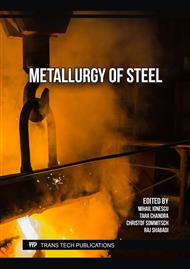p.13
p.19
p.29
p.35
p.41
p.47
p.53
p.61
p.81
Microstructural Characteristics and Mechanical Properties of Nanostructured Bainite Processed through High and Low Temperature Ausforming and Isothermal Holding near Ms in a Medium Carbon Steel
Abstract:
Laboratory rolling simulations, comprising of thermomechanically controlled rolling followed by ausforming and isothermal holding close to Ms temperature, were conducted on a medium-carbon (C) steel in order to understand the combined effect of prior straining and low temperature holding on the bainite transformation characteristics and resultant properties. Field emission scanning electron microscopy (FE-SEM) was employed to examine the morphology, size and volume fraction of different phase constituents and the observed microstructural features were correlated with the mechanical properties of the steels. The morphology of bainite and/or retained austenite (RA) after low temperature ausforming was found to be extremely fine compared to the sample ausformed at high temperature. An excellent combination of high yield (~1200 MPa) and tensile (~1800 MPa) strengths, good ductility (~18 %) and reasonable ambient temperature impact toughness (~15 J/cm2) were achieved in the low temperature ausformed steel that was attributed to significant refinement of bainite sheaves and presence of high fractions of film-like RA. The dislocations introduced by ausforming hindered the growth of bainite and promoted enhanced carbon diffusion, resulting in high fractions of finely divided film-like RA with high stability. Recent results obtained on a nanostructured /ultrafine medium-carbon bainitic steel elucidating the ausforming conditions and corresponding microstructures and properties are illustrated here.
Info:
Periodical:
Pages:
41-45
Citation:
Online since:
November 2023
Authors:
Price:
Сopyright:
© 2023 Trans Tech Publications Ltd. All Rights Reserved
Share:
Citation:



